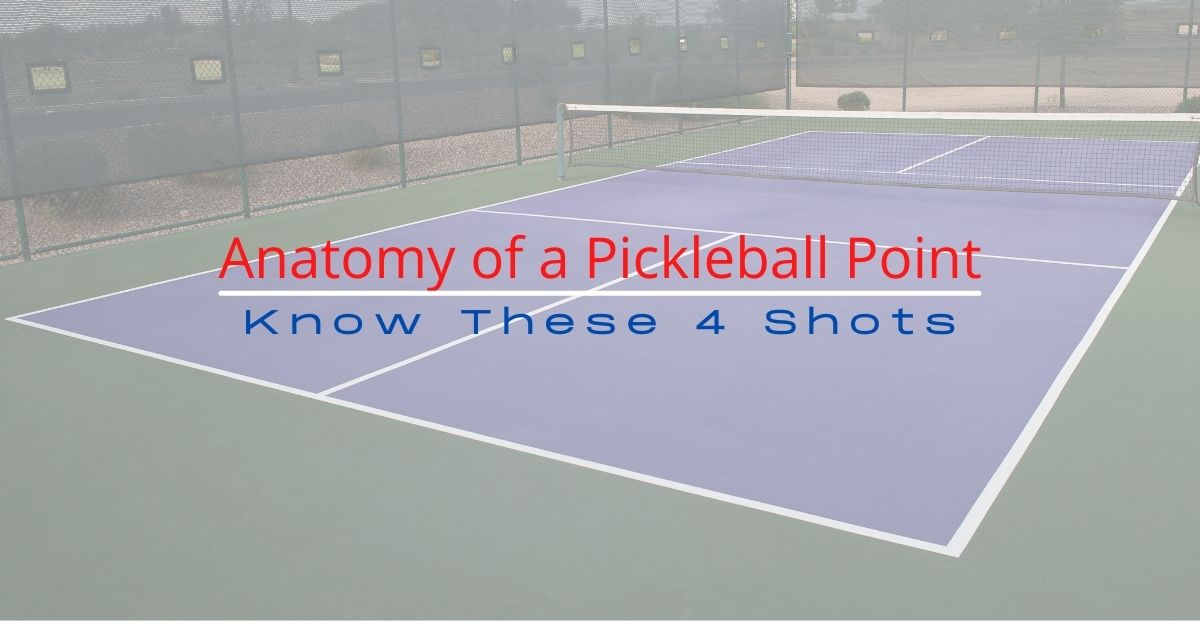The 4 Shots of Pickleball
There are just four parts to a pickleball point. Said another way, there are really only 4 shots you need to learn to play pickleball:
- The Serve
- The Return
- The Transition
- No Volley Zone
If you are not too familiar with pickleball, here’s a nice review of the rules of pickleball to help you understand the rest of this article.
The Serve
While you must serve to score a point in pickleball, the serve is probably the least offensive serve of ANY game. In fact, there is no advantage to serving other than the ability to score a point.
You must serve cross court. That’s it. It’s basically a courteous way to start a point. It must be served underhanded or by a drop serve, and it’s usually neither a powerful nor fast shot (i.e. it’s unlikely you’ll ace your opponent).
Goals of the pickleball serve:
- Land in
- Land deep
- Avoid faults (free points)
The Return – Middle is the Riddle
Compared to the serve, this can be an offensive shot.
Goals of the pickleball return:
- Land deep
- Placed in between your opponents (in the middle of the court)
- Hit slowly
Deep shots are simply harder to return as most players are out of position to properly attack a deep return. They usually have to back up, making the 3rd shot almost impossible to be effective. A deep ball is also almost impossible to attack, e.g. it’s much easier to drive a short ball compared to a deep ball.
Placement of the ball between your opponents can often cause confusion between your opponents, giving you an easy point. Remember “Middle is the Riddle.”
The pace of the ball should be moderate to slow. The slower you hit the ball, the more time you have to charge the NVZ. I always recommend hitting a slow to moderate return with the goal of positioning yourself at the NVZ as your opponent is about to hit the 3rd shot. Your positioning at the NVZ as your opponent is hitting a transition shot (3rd shot, 3rd shot drop) may be very intimidating and give you an easy ball to hit.
More experienced players may also choose to exploit an opponent’s weakness. For instance, you may choose to attack an opponent with a weak backhand.
The slice return is also becoming very popular as the ball doesn’t bounce very high and skids.
The more complicated the return, however, the higher the chance of making a fault. Keep it simple, if nothing else, return the serve with a safe deep shot.
Transition Shot – aka 3rd Shot
Perhaps the most difficult to perform, yet most important part of pickleball.
The 3rd Shot is the third shot of a point:
- First Shot: The Serve
- Second Shot: The Return
- Third Shot: Transition (up to the NVZ)
As noted above, the serve is merely a shot to get the point started. Compared to other sports, there is really no advantage to serving other than giving your opponent the chance to give you a free point.
The second shot (aka the return) can be an offensive shot, but it also gives the returning team the FIRST advantage to get to the NVZ (no volley zone).
The serving team must hit a 3rd shot that gives them the chance to claim their spot at the NVZ. The serving team is usually at a disadvantage at this point be cause the returning team got a head start in getting to the NVZ.
Whether to drop or bang is the question. Regardless if you hit a drop shot or a drive, the goal is to give yourself a chance to get to the NVZ.
Dinking – Play the game “Below the Net”
A dink is a defensive shot. Properly executed, a dink prevents your opponent from hitting a winner or a put-away. In other words, dinking keeps your game “below the net.”
Once both sides are at the NVZ, the real strategy and mind games begin. The goal of dinking;
- Get your opponent out of position (to open a hole or pop up the ball)
- Change the stance of your opponent (to pop up the ball)
- Do not give your opponent to hit a winner
The better players have the skill and patience to get their opponents either out of position and MAKE their opponent pop up a ball high enough for a put-away.
Balls that are too high (above the net) can be easily put-away.
Thanks for Reading. Remember to keep your game:
“Below the Net,”
Randy Wong, PPR
Bob Lynn, President





No Comments
Sorry, the comment form is closed at this time.